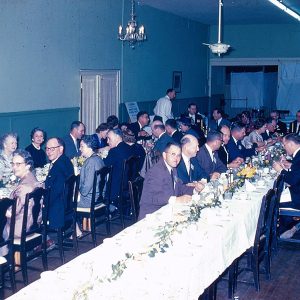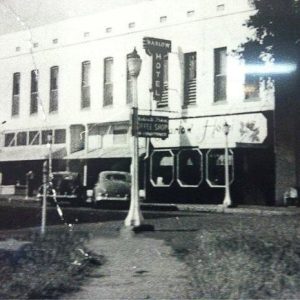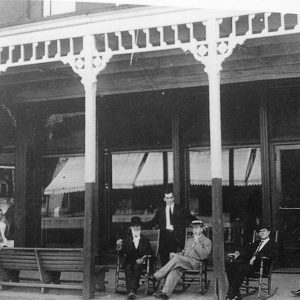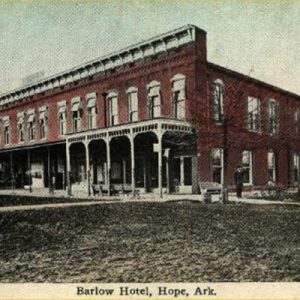calsfoundation@cals.org
Barlow Hotel
The Barlow Hotel at 102 South Elm Street in Hope (Hempstead County) was, for more than seventy-five years, the city’s most popular lodging and dining venue, as well as its most sought-after meeting and banquet facility.
The Barlow was built as the Lamar Hotel by local merchant J. C. McKee and opened in 1886, ten years after the town’s founding. It initially sought to attract a clientele dominated by railroad passengers, as Hope was built around what would become two major railroad junctions: the north-south Louisiana and Arkansas line (now Kansas City Southern) and the east-west Cairo and Fulton (now Union Pacific). In 1886, M. H. Barlow, a hardware merchant who hailed from Cory, Pennsylvania, was persuaded that the hotel, in a growing railroad town, was a good investment, and began almost eight decades of family ownership of what was fast becoming a popular regional lodging and dining venue. M. H. Barlow had four children, three who went into the hotel business: John D. Barlow, who took over the operation of the Barlow in 1904; R. P. “Dick” Barlow, who in 1928 took over a Malvern (Hot Spring County) hotel that had opened in 1896; and Henry Barlow, who operated the Barlow Hotel in De Queen (Sevier County) from 1931 until poor health forced his retirement ten years later. M. H. Barlow’s daughter, Dr. Alice Barlow Brown, served many years as a medical missionary in China.
John Barlow announced in 1930 plans for a ten-story replacement for the Barlow, but worsening economic conditions during the Great Depression put an end to those plans. Barlow, however, continually upgraded the popular establishment: it was the first facility in the city to have hot and cold running water and was said to be the first customer of Hope Water and Light (in about 1910). For years, the hotel’s strawberry shortcake was popular with both local and traveling diners. William Jennings Bryan also visited the Barlow in the early 1920s. The Barlow became the hub of civic and community meetings and banquets in the community. In time, the hotel accommodated retail businesses such as Middlebrooks’ Grocery, Singer Sewing Machines, Ladies’ Specialty Shop, and Arkansas Louisiana Gas Company (Arkla). Arkla founder and president W. R. “Witt” Stephens was close friends with Barlow, and Barlow was an initial investor in Arkla when Stephens purchased the firm from Cities Service Oil Company. Witt Stephens’s younger brother, Jack Stephens, worked for several summers at the Barlow as a busboy. Barlow sold the hotel in 1943 to the Lampkin estate while still remaining an active leader in the hotel trade associations.
Ben Owen, a Hope businessman with department stores in Arkansas, Texas, and Oklahoma, purchased the hotel in 1960 and made long-awaited upgrades, such as a stand-alone coffee shop and an enlarged 250-seat banquet room; he had plans, too, to add another twenty rooms. On September 14, 1964, however, when an electrical fire that began in the kitchen swept the hotel, destroying the famous landmark and surrounding businesses, and killing three hotel guests.
Lodging and restaurant facilities in Hope began moving to Third Street (U.S. Highway 67), and ultimately Interstate 30. The site once occupied by the Barlow became the home of the Melon Patch Restaurant.
For additional information:
“60 Years of Hotel Keeping Celebrated.” Hope Star, December 27, 1946, p. 3.
“Four Businesses Here Gutted by Fire; Hotel Guest Loses His Life.” Hope Star, September 14, 1964.
Hanley, Ray, and Steve Hanley. A Journey through Arkansas: Historic U.S. Highway 67. Mount Pleasant, SC, Arcadia Publishing, 1999.
Haycox, Richard, ed. Reflections: A Pictorial History of Hope and Hempstead County. Marceline, MO: D-Books Publishing, Inc., 1998.
“Old Landmark at S. Elm, Front Street, Hotel Barlow, Is Revived by Local Man.” Hope Star, June 18, 1960, p. 1.
Shiver, Harry W., ed. A Centennial History of Hope, Arkansas 1875–1975. Hope, AR: Etter Printing Company, 1975.
Revis Edmonds
Arkansas State University
 Business, Commerce, and Industry
Business, Commerce, and Industry Post-Reconstruction through the Gilded Age, 1875 through 1900
Post-Reconstruction through the Gilded Age, 1875 through 1900 Barlow Hotel Banquet
Barlow Hotel Banquet  Barlow Hotel
Barlow Hotel  Barlow Hotel Porch
Barlow Hotel Porch  Barlow Hotel Postcard
Barlow Hotel Postcard 




Comments
No comments on this entry yet.